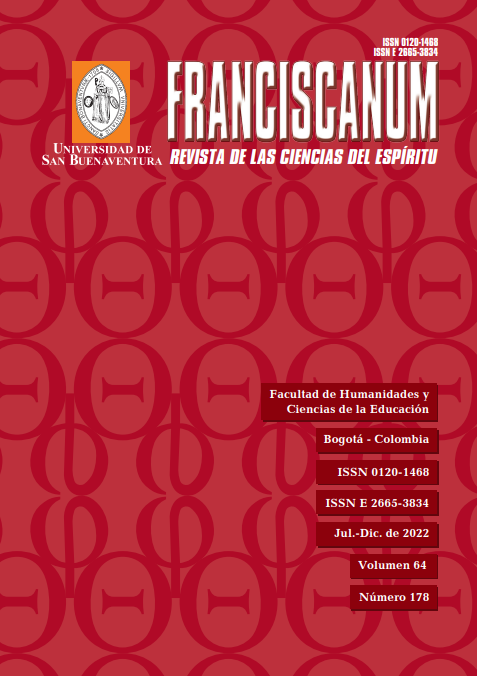This journal provides immediate open access to its content, based on the principle that giving the public free access to research helps a greater global exchange of knowledge.
Therefore, the Creative Commons 4.0 Attribution Attribution - Equal Share (by-sa) License is accepted: The commercial use of the work and the possible derived works is permitted, the distribution of which must be done with a license equal to that regulates the original work.
http://creativecommons.org/licenses/by-sa/4.0/
Along these same lines and in line with the Open Access policy, it is clarified that the authors maintain their rights to articles, without restrictions and, in the same way, they maintain their publication rights, without restrictions. They are only asked to reference the number of the Franciscanum magazine where the article initially appeared.
Abstract
The origin of this article is the concern for the distance of Christianity from the sufferings of humanity. This deficiency should be remedied by a Christology that, obedient to the fundamental indication of Chalcedon, meets the path of aphartodocetism. Likewise, Latin Christology would have to recognize the soteriological value of the mystery of Christ as a whole, and not concentrate salvation on the cross for the forgiveness of sins. In history there are innocents. The Latin American Christology of Liberation has been able to offer historical liberation to these victims by means a Trinitarian following of Christ.
References
Briancesco, Eduardo. «Sentido y vigencia de la cristología de San Anselmo. Ensayo de lectura estructural del “Cur Deus Homo” (1ª parte)». Stromata 1-2, Vol. 37 (1981): 3-18.
Briancesco, Eduardo. «Sentido y vigencia de la cristología de San Anselmo. Ensayo de lectura estructural del “Cur Deus Homo” (2ª parte)». Stromata 3-4, Vol. 38 (1982): 283-315.
Costadoat, Jorge. «La cristología en América Latina antes y después de Medellín (1968). Giro en la comprensión de la cruz». Franciscanum 174, Vol. 62 (2020): 1-23.
De Canterbury, Anselmo. «Por qué Dios se hizo hombre». En Obras completas de San Anselmo. Vol. I. 737-891. Madrid: BAC, 1952.
Di Bizanzio, Leonzio. «Dialogo contro gli afartodoceti». En Le opere. Introduzione, traduzione e note a cura di Carlo Dell’Osso. Roma: Città Nuova, 2001.
Ellacuría, Ignacio. «Discernir el “signo” de los tiempos». Diakonía 17 (1981): 45.
Garrigou-Lagrange, Reginald. La unión del sacerdote con Cristo, sacerdote y víctima. Madrid: Rialp, 1955.
Guardini, Romano. El Señor. Sobre el Dios vivo. Madrid: Rialp, 1960.
Gutiérrez, Gustavo. Hablar de Dios desde el sufrimiento del inocente. Salamanca: Sígueme, 1986.
Gutiérrez, Gustavo. Teología de la liberación: perspectivas. Salamanca: Sígueme, 1972.
Hubert Robinet, André. Palabras de creación. La creación en la teología y el método teológico de San Anselmo de Canterbury. Anales de la Facultad de Teología 55/1. Santiago de Chile: Pontificia Universidad Católica de Chile, 2004.
Marmion, Columba. Jesucristo en sus misterios. Santiago de Chile: Difusión chilena, 1943.
Papini, Giovanni. Historia de Cristo. Buenos Aires: Mundo moderno, 1945.
Polanco, Rodrigo. «La encarnación en la teología de San Ireneo de Lyon». Sapientia Patrum. Anales de la Facultad de Teología 2, Vol. 51 (2000): 43-89.
Ricciotti, Giuseppe. Vita di Gesù Cristo. Barcelona: Luis Miracle, 1948.
Richard, Pablo. La lucha de los dioses. San José: Departamento Ecuménico de Investigaciones, 1980.
Scannone, Juan Carlos. Evangelización, cultura y teología. Buenos Aires: Guadalupe, 1990.
Segundo, Juan Luis. Teología abierta. Reflexiones críticas. Vol. II. Madrid: Cristiandad, 1983.
Sesboüé, Bernard. Jesucristo, el único mediador. Vol. I. Salamanca: Secretariado Trinitario, 1990.
Sesboüé Bernard y Joseph Wolinski. El Dios de la salvación. Salamanca: Secretariado Trinitario, 1995.
Sobrino, Jon. «“El resucitado es el crucificado”. Lectura de la resurrección de Jesús desde los crucificados del mundo». En Jesús en América Latina. Su significado para la fe y la cristología. 235-250. Santander: Sal Terrae, 1982.
Sobrino, Jon. Jesucristo liberador: lectura histórico-teológica de Jesús de Nazaret. Madrid: Trotta, 1991.
Sobrino, Jon. La fe en Jesucristo. Ensayo desde las víctimas. Madrid: Trotta, 1999.
Sobrino, Jon. «Teología en un mundo sufriente. La Teología de la liberación como “intellectus amoris”». En El principio misericordia. Bajar de la cruz a los pueblos crucificados. 47-80. Santander: Sal Terrae, 1992.
Tepedino, Ana Maria. «Gender and New (Re-newed) Images of the Divine». Voices from the Third World 1, Vol. 24 (2001): 84-96.
Trigo, Pedro. Jesús nuestro hermano. Acercamientos orgánicos y situados a Jesús de Nazaret. Santander: Sal Terrae: 2018.
Vélez, Consuelo. Cristología y mujer. Una reflexión necesaria para una fe incluyente. Bogotá: Pontificia Universidad Javeriana, 2018.

 Perfil Google Scholar
Perfil Google Scholar


















